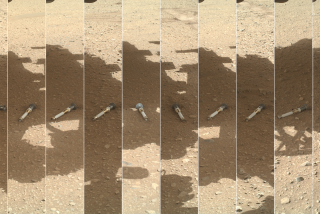Scientists discuss rover’s upcoming mountain climb on Mars
In August, NASA’s Mars Science Laboratory will reach the Red Planet and begin its search for habitats that could have supported life. The next-generation rover, better known by the nickname Curiosity, will pick its way up a mound in the middle of Gale crater and look for evidence that water once flowed on the Martian surface — a condition that is considered a prerequisite for hosting microbial beings.
On an expedition to the California desert this month to demonstrate some of the challenges Curiosity will face on Mars, scientists chatted about the upcoming mission. They included Caltech geologist John Grotzinger, the mission’s head scientist, and Ken Edgett, a senior research scientist with Malin Space Science Systems in San Diego, who is in charge of one of the rover’s cameras.
Of the four promising landing sites on Mars, why pick Gale?
John Grotzinger: My No. 1 reason to select Gale was you know immediately what your exploration direction is going to be: Start at the bottom, go right to the top.
Ken Edgett: If you’re interested in these questions about water and lakes and life and all of that, go to Eberswalde [a crater containing a delta]. If you want to know about Mars and its history, go to Gale, because nowhere else do you get 5 kilometers of Mars history in a record like that.
So just to be clear, you guys aren’t looking for life on Mars.
JG: I don’t think we can concern ourselves, scientifically, with whether life evolved on Mars. What we’re doing is an exploration of habitable environments. So we just assume life had evolved, and then we look for those environments where it might have been present in ancient times.
We’re specifically looking for the subset of those habitable environments that might have preserved some signal that the life had once been there.
Are the drivers nervous about climbing Mt. Sharp [inside Gale]?
KE: I think it bores the rover drivers if you said, “We’re going to land on this flat plain and we’re never going to leave it. And we just want you to put the pedal to the metal and do 200 meters a day.”
But if you said, “Now we’ve got to pick our way up this slope, and sometimes we’re going to want to go backward and sometimes we’re going to go sideways,” they think that’s awesome. So they like that challenge.
What are some significant challenges for mission scientists?
KE: To get enough rest and to keep your head clear enough to think about, what are we learning here? We have limited time, so I think that my concern would be, what are we going to miss that we shouldn’t have missed?
You’ll never know what you miss. And I think the frustration at Gale will be that you can’t study the heck out of it, because you get one trip up the mound — you won’t get to go back and forth.
JG: The problem with the rover is what the time scale of discovery is, compared to walking on your feet. Something that might have taken you an hour is going to take three months.
Since a day on Mars is about 40 minutes longer than a day here, and working on Mars time can knock scientists out of sync with a normal Earth day, are there bragging rights that go along with this?
KE: It’s a gate you pass through and then everyone thinks you’re awesome or whatever: “Wow, you did Mars time!”
But then there’ll be all the people who say, “Well I did it twice. You’re nobody until you do it twice.”
Curiosity is too heavy to land on the Martian surface with air bags, so engineers designed the so-called Sky Crane to lower the rover to the ground from a hovering landing craft. It looks a little complicated.
JG: It’s just analogous to building a big new-generation fighter or bomber — at some point somebody has to go on the maiden voyage, and there’s a big risk associated with that. But they seem to be very confident. We’ve had every combination of people coming in and reviewing this thing, and I never see anything but real confidence.
What do you like best about the Sky Crane?
JG: We were able to basically land with an equal probability of success in the four final landing sites — which left the science as the final arbiter in choosing the landing site. This is unprecedented. If you look forward to the next decade, I think we’ll see it was one of the greatest successes of [Mars Science Laboratory] already.
These questions and answers have been collected from a series of discussions and edited for space and clarity.







